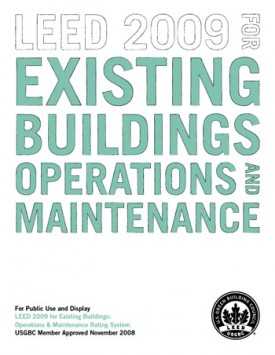Building owners across the country are considering two prominent energy efficiency certification programs, LEED and ENERGY STAR. So what's the difference?
The Leadership in Energy and Environmental Design (LEED) rating system takes into account water efficiency, innovations in operation, materials and resources, sustainable sites, indoor environmental quality, and energy and atmosphere. ENERGY STAR gives 1-100 ratings through the Portfolio Manager platform to rate a building's energy performance based on energy use and building attributes such as square footage and number of computers. Both rating systems have spurred a rise in building energy efficiency and a lot of money saved.
These rating systems 1) set a high standard, 2) set benchmarks and a standard language, 3) encourage innovation, 4) bring measured energy efficiency to the public eye, and 5) clearly outline ways to improve. In this blog we provide an overview of how the two systems work, and how ENERGY STAR ratings are now used in the LEED Existing Buildings: Operations & Maintenance (aka LEED-EBOM) system.
What Is LEED-EBOM?
Believe it or not, there are 9 different types of LEED rating systems. Each one is targeted toward a particular project type, like schools, healthcare, new construction, or existing buildings. While there is definitely crossover between the rating systems, qualification for one certification does not necessarily mean qualification for another. Currently, LEED for Existing Buildings: Operations and Maintenance, or LEED-EBOM, is the fastest growing LEED rating system.
 LEED-EBOM encourages property owners, managers, and operators to improve the sustainability of their existing building while taking into account daily operations. Specifically, LEED-EBOM's "built-in prescriptive and performance strategies are intended to provide operational benefits throughout the life of the building. By sustaining these strategies, the building can maintain and even improve its performance over time."
LEED-EBOM encourages property owners, managers, and operators to improve the sustainability of their existing building while taking into account daily operations. Specifically, LEED-EBOM's "built-in prescriptive and performance strategies are intended to provide operational benefits throughout the life of the building. By sustaining these strategies, the building can maintain and even improve its performance over time."
How LEED-EBOM Has Changed
In 2008, LEED for Existing Buildings was revised to focus on operational performance using real measured data. As USGBC put it, “The new structure and clarity of the LEED for Existing Buildings: O&M Recertification program will help encourage a culture of ongoing performance verification." This system is intended to keep track of and incentivize continuous improvement in energy efficiency.
Moreover, the “projects that certify under any version of LEED for Existing Buildings must re-certify at least once every five years in order to keep their certification current.” It is important to recertify because in many cases, existing buildings can fall out of sustainable shape. What is great about LEED-EBOM is that it emphasizes “the importance of ongoing performance verification while still maintaining the connection to daily operations."
LEED Certification Uses Energy Star
We all know that if we see the blue ENERGY STAR label on an appliance such as a washing machine or a refrigerator, it is going to be above a certain standard of efficiency. ENERGY STAR also manages a performance rating for buildings. This same rating plays a key role in LEED-EBOM. In fact, as a prerequisite, all LEED-EBOM certified buildings must go through ENERGY STAR's Portfolio Manager to get a score. In order to be LEED-EBOM qualified, an existing building must attain a score of 69 or higher. A score of 69 signifies that a building is performing better than 69 percent of similar buildings.
The point system for LEED-EBOM incorporates ENERGY STAR's rating system. An ENERGY STAR score of 71 gives 1 point toward LEED-EBOM, a score of 73 gives 2 points, a score of 74 gives 3 points, and so on until a score of 95 gives a maximum 18 points. The average ENERGY STAR score for all LEED certified buildings is an 85, giving 13 points towards LEED-EBOM certification. This of course, is only one element of the LEED-EBOM point system.
LEED-EBOM Point System vs. ENERGY STAR
LEED’s rating system cites six important aspects that are involved in a building’s operations. They are:
- Exterior building site maintenance
- Water and energy use
- Environmentally preferred products and practices for cleaning and alterations
- Sustainable purchasing policies
- Waste stream management
- Ongoing indoor environmental quality
There is a LEED-EBOM checklist that serves as a guideline to getting certified. It has a total of 110 possible points; however, as you can see in the breakdown below, a mere 40 points will get a building certified. This list is a breakdown of the 7 overarching topics that are taken into account:
- Sustainable sites (26 pts)
- Water efficiency (14 pts)
- Energy and atmosphere (35 pts)
- Materials and resources (10 pts)
- Indoor environmental quality (15 pts)
- Innovation in operations (6 pts)
- Regional priority (4 pts)
LEED 2009 for Existing Buildings: Operations & Maintenance certifications are awarded according to the following scale:
- Certified: 40-49 points
- Silver: 50-59 points
- Gold: 60-79 points
- Platinum: 80 points and above
To sum it up, most improvements–like using sustainable cleaning equipment or reporting emission reductions–are worth 1 point each. A few, like optimizing energy efficiency performance and renewable energy, are worth more, reflecting the impact such improvements can have.
Authors: Tammy Bui and David Segan
This post originally appeared on the WegoWise blog. IMT cross-posts content for educational purposes only and not to endorse particular companies, products, or services.